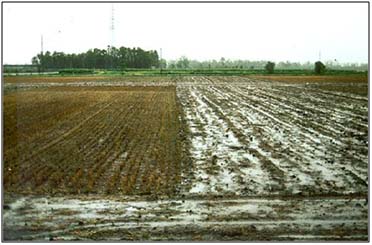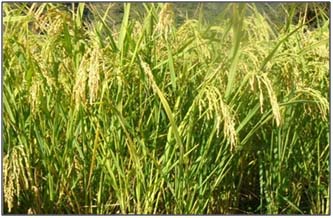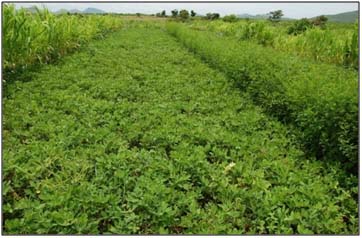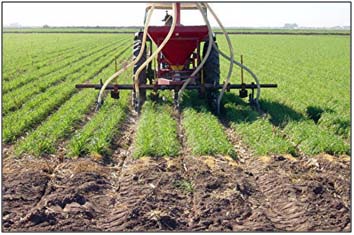
Image courtesy: Center for Advancement of Sustainable Agriculture (CASA)
With support from Indian Council of Agricultural Research (ICAR), a day-long national seminar followed by half a day meeting to discuss follow-up action was organized by Center for Advancement of Sustainable Agriculture (CASA) and Society for Promotion of Wastelands Development (SPWD) at National Agriculture Science Center (NASC) complex, New Delhi on February 14 and 15, 2012.
The objectives of the seminar were to (1) share experiences and approaches to address Soil Health and Climate Change related issues (2) share the concept and approaches of Conservation Agriculture (CA) to address issues of soil health and building farming systems’ resilience to increasing climate related uncertainty (3) outline a strategy for networking of field based organizations to promote learning and information exchange to address location specific problems (4) explore opportunities for improved linkages of grass root organizations with local research outfits in respective regions.
There were sixty five participants from different states from the field of agriculture and social sciences, non-government organizations and fertilizer industry. The background and context of the seminar was provided by Dr. IP Abrol, Director, CASA and the structure of seminar and the introduction to different sessions were detailed by Mr Viren Lobo, Executive Director, SPWD.
Referring to concerns raised on soil health by the Farmer’s Commission report, brought out by the Swaminathan Committee, Dr. Abrol said that the issue has been gaining increasing importance due to the rising cost of inputs like fertilizer and water which is presently highly subsidized by government directly or indirectly (subsidized electricity for groundwater extraction). The need to provide subsidy to keep agricultural prices low combined with need to subsidize food items for providing food security to a large part of population has increased the total subsidy burden on government exchequer. Need to progressively increase fertilizer and water application to maintain crop productivity levels have drawn attention of all the concerned to the issue of soil health.

Dr. Abrol narrated the conditions that necessarily made us view soil inIndiain a particular way. He pointed out that at the time of independence the average productivity of food-grains that could be got from Indian soils was merely around 500 Kg/hectare. This was because of loss of organic content due to repeated tillage for centuries following clearing of forests for preparing land for agriculture. The loss of organic matter meant that whatever small amount of nitrogen was annually fixed in soil because of natural processes became available on tillage by oxidation of carbon and, subsequently soils were left with little nitrogen for the plants. This deficiency of nitrogen became the limiting factor for crop production. The progressive loss of organic matter also meant that the capacity of soils to retain water got reduced over time.
Various methods adopted by farmers to harness available nitrogen and water namely leaving the land fallow, ploughing back green manure and application of farmyard manure could not break the average productivity barrier of around 500Kg/hectare, since low levels of productivity also meant that the availability of farmyard manure was also low.
While the green revolution succeeded in overcoming the constraint of low availability of nitrogen that had in the main restricted the increase in crop productivity, through the application of inorganic fertilizers, experiences have shown that merely making available nitrogen or other nutrient, in the form (inorganic) that is appropriate to their uptake by the plant, though necessary in the given conditions, was not sufficient. The nitrogen and other required nutrients have to be made available to the plant in right dosages as per plant’s need depending on its stage of growth and other factors in a manner that minimizes the wastage of added fertilizer. This means in addition to making available required nutrient, one needs to improve the fertilizer-use efficiency. The same is true about water.
Participants of the seminar representing different sectors observed that the efforts so far have focused on creation of soil testing labs and provision of soil health cards to farmers so that the farmers apply in a balanced manner only the required amount of macro and micro nutrients to the soil. This effort while addressing the immediate problem does not touch the major issue of concern, which is to improve fertilizer and water use efficiency. The participants stressed that earlier the focus was on increasing crop productivity only by feeding plants with essential nutrients by way of applying inorganic fertilizers and viewing soil as medium for the application notwithstanding the regulatory function of the soil which it must perform for improving fertilizer and water use efficiency, now there is a need to focus on the various aspects of soil and the processes involved for checking its further deterioration and building it progressively for it to perform its entire range of functions, which are more than fertilizer and water use efficiency, and are characteristic and also indicator of status of soil health.
Dr A K Singh DDG (NRM) pointed out that soil has to bear the brunt of everything and there is a need to evolve integrated local specific solutions for sustainability. He also mentioned that the Government is planning to support initiatives in Conservation Agriculture. Dr K. D. Kokate DDG (Extension) pointed out the need to develop the capacities of the KVKs at the district level to deal with the issues related to soil health. He mentioned that agriculture must go back to its roots i.e., look at ways of recreating healthy soils.

Globally it has been found that keeping the soil as undisturbed as possible and leaving residue on the soil are the two major factors that contribute to enhancing the health of the soil. Conservation Agriculture (CA) involving no till and mulching together with appropriate crop rotations has emerged as a paradigm that can guide search for evolving concrete set of location specific farming practices that can help combine farmers’ need of improved incomes with improving conditions of production (soil health). The paradigm helps in defining and monitoring sustainable farming practices to get out of the present impasse of sustaining productivity through high cost inputs with low input use efficiency and natural resource degradation. It also provides a way to respond to locally defined natural resources management related problems.
Dr R K Gupta, CIMMYT, elaborated on CA and described it as an agro-ecological approach to sustain crop production and intensification. As an approach, integrative of its parental disciplines of agronomy, ecology and socio-economics across scales, it provides multiple options to the farmers endowed differentially as to natural and cultural resources. Hence ‘one size fits all’ type general recommendations may not be helpful for CA, and one needs to operationalize its unvarying basic tenets as per specificities of locations. This is possible because the principles involved in putting CA into practice are ‘divisible’ in operations’ and ‘flexible’ in applications.
Adopting CA principles involves shift from (1) excessive tillage with associated runoff to drastically reduced tillage combined with in situ soil and moisture conservation (2) residue burning or incorporation to surface retention of residues and (3) crop based management to cropping system based management. This in effect means minimum disturbance of soil and replacement of green manure incorporation and ex-situ farm yard manure with brown manure and in-situ compost resulting from surface drying of residue and other organic material. It also means crop diversification informed by ecological principles in place of focusing on productivity of single crop.
The adoption of CA principles helps not only in improving soil health with associated improvement in fertilizer efficiency but also increases much required water use efficiency in agriculture. A study by 2030 Water Resource Group have compared the costs involved in meeting the water demands in year 2030 and has found no-till technology to be the best option involving negative costs. Dr. Gupta enumerated the factors that are restricting the spread of CA inIndiain spite of CA’s potential to benefit farmers under diverse conditions. These are poor policy support, low access to CA machinery, low public sector investments and no formal training in State Agricultural Universities.
Mr Gopi Krishna from Greenpeace questioned the need to go for brown manuring (use of weedicide spray) as an alternate way to improving soil health. Dr. ML Jat, CIMMYT and Dr. Yadav, HAU shared the encouraging outcome of the efforts made to ground CA for different farming systems in different locations in both irrigated and rainfed conditions. Dr. Jat allayed many misconceptions on agricultural practices in general and CA in particular. He invited participants to visit CIMMYT experiment fields. Dr. Yadav said that a multidisciplinary team from HAU has been involved in CA experimentation for last 15 years. The University would be in a position to come up with a comprehensive package of practices over the next two to three years.
Another presentation on grounding of CA was made by Dr Abha Paranjpe from a Nagpur based NGO - AVNI. She provided a lucid account of the grassroot attempt to develop farmers’ interest and participation in conservation agriculture. According to her, the major reason for farmers’ interest in CA was the reduction in labor cost without compromising with the crop productivity and, the major motivating factor for change was the day to day presence of back up support which helped the farmers to withstand peer pressure, examine the field conditions rationally and develop situation specific options to deal with it. The programme which began with just three farmers in the first year now has 28 famers in the second year spread over three districts. The experiments have expanded to cover all crops except vegetables.

Dr R K Gupta, National Consultant (Soil Management), Department of Agriculture and Cooperation, warned against the tendency to generalize on the basis of limited observations. He mentioned the need to identify niche areas for conservation agriculture where with a little bit of effort the results could be considerable. One needs to look at the opportunities available in the tribal areas where productivity is low, chemical agriculture is non-existent. One also needs to look at rainfed areas and regions where multi-cropping systems are being initiated. He informed that the 12th Plan has made considerable provision for conservation agriculture and SRI. Promotion of intercropping, multi-cropping, zero tillage etc., are to be supported in big way under the Plan.
Dr Rajeshwari Raina, picking up on the point raised earlier in the day by Dr. IP Abrol, reemphasized that it is not necessarily scientists who would lead innovations in future in the farming sector. She stressed on the importance of agro-ecological system approach to understanding soils and also the manner in which these are used. Further elaborating on the point she said that it needs no underscoring that the best of research is required to understand soil physical, chemical and biological processes but understanding interaction among these and socio-economy would provide key to sufficiently understand determinants of soil health.
Here understanding of communities’ and local NGOs’ about local resources and their use turns out to be a very crucial input. Hence, they are not to be looked as recipient of technology but partners in research and technology development. Farmers’ knowledge and practices need to be recognized and their rationale understood. NGOs can play a key role in formulation of the research problem and also capacity building at different levels to make all the relevant actors participate in evolving location specific solutions. This becomes all the more important when demand for water and fertilizer is rising along with cost of their provisioning. Once state withdraws from providing subsidy for these, farmers would have to cope with the resultant crisis using their own local resources. Research and technology development need to be carried out in the light of the new developing situation. Agro-ecological approach presents the way out.
Dr N K Sanghi, representing the RRA network, remarked that the focus at present of different ongoing programmes was on soil conservation and not on soil health. He informed that RRA had evolved a programme for living soils which was experimenting with 10 ways to make the soil living. He said that along with zero tillage one needs to incorporate zero pesticide and zero fertilizer. He maintained that soil health can be improved in multiple ways and there is a need to look at widening our horizon to do so. In order to try out these multiple ways there is a need for support systems and incentives which include equipment, infrastructure, labour, involvement of CBOs and NGOs and large scale demonstrations.
Mr B G Mahesh from Chetna Organic, a part of the RRA network, while explaining the structure and functioning of RRA network, explained in detail the ten ways being taken up by RRA network to improve soils.
Dr Manohar Singh Rathore, CEDS, while echoing the call of earlier speakers to involve NGOs pointed to the fallacy of the system for which involving NGOs has turned out to be an exercise of extending and replicating itself. This is apparent in the practices followed in selection of NGOs, for instance through inviting tenders and keeping criteria of selection that could be fulfilled only by large corporatized NGOs instead of taking into account the concrete strengths of NGOs to innovate and respond to location specificity and develop local level plans. Not recognizing the necessary conditions that are conducive to taking up location specific decentralized planning, the system ends up promoting dependency and short sightedness. A holistic approach to development tailored to the local environment will help ensure that the money is well spent.
Dr Ramendra Singh from Tata Chemicals started his presentation by saying that soil health cannot be described. What we are able to understand and measure are soil quality attributes. He explained how soil degradation has negatively impacted global agricultural production capacity and food security. From year 1970 onward there has been continuous decline in fertilizer response measured as ratio of Kg grain to Kg NPK from 13.4 (year 1970) to 3.7 in year 2010 in irrigated areas. Along with the decline of response to NPK, there emerged progressively multi-nutritional deficiency in soils. In year 1950 Indian soils were deficient in nitrogen, in year 1960 the deficiency of iron emerged along with nitrogen. In year 1970, 1980 and 1990 the deficiency of phosphorous, zinc and potash; sulphur and manganese; and boron respectively were added on to the list of deficient nutrients in Indian soils.

Reduced partial factor productivity of NPK, reduced soil nutrient availability, contamination of groundwater and frequent occurrence of extreme weather phenomenon have become the Indian farmers’ concerns. The introduction of zero-till in rice-wheat system as it is practiced today, requires solution to the problem of delayed sowing of wheat and introduction of newer pests/insects. The improvement of soil health requires nutrient management, water management, integrated pest management and adoption of appropriate soil tillage methods.
Dr Naveen Kalra presently working with Tata Chemicals, appraised of the efforts of their organization to develop and provide sustained fertilizer mixtures to suit various situations. He talked about issues in the mining regions and intercropped areas . He stressed the relevance of in-situ water management and need to introduce situation specific relevant farm mechanization. Dr S. V. Karore of IFFCO mentioned that they are already devoting significant amount of resources to address issues of soil health.
Dr Prasad of AME foundation and Dr Rawal of BAIF shared the experience of their respective organizations. Conceptualizing the co-learning process where subject matter specialists and farmers participate, Dr Prasad focused on the need to take into account specialized versus holistic approach and long term versus short term context specific solutions. The co-learning process should aim to open the horizon to facilitate bringing together seemingly contradictory elements into an integral understanding that would help achieve the twin goals of productivity and sustainability.
Dr Rawal of BAIF talked of the role of livestock in converting biomass into something usable. He also talked of models that take into account sustainability of the production systems of specific communities particularly weaker sections like tribals. He stressed on a need for R&D to develop area specific approaches for Conservation Agriculture that take into account the local economy. In this context he mentioned the case study of Thadanpalli to highlight the rationale of a farmer to partition his/her time between farming and industrial labour in presence/absence of given factors including the risk factor in agriculture that in totality determines for him/her the link between input/output of farming and industrial labour. Dr Virmani in his comment as chair of the session remarked that the logic of the marginal famer to get small incremental income from agriculture while not wasting too much time is very reasonable and needs to be taken into account while formulating plans and policies for rejuvenating natural resources health.
Dr Rajender Prasad from Dhanuka Agrotech while talking about the lack of adequate soil testing facilities explained the efficacy of mobile soil testing labs and the need to provide basic training on soil health parameters to dealers and salesman who have to deal at ground level on a day to day basis. He also stressed the need for a multiagency approach so as to be able to better deal with the complexities on the ground, the need to better equip the KVKs was also stressed.
Dr Amit Rastogi from Coromandel International Ltd. mentioned that Conservation Agriculture has come as a response to the declining factor productivity in the agriculture sector. Reduction is fertilizer and water use efficiency has increased the necessity to provide inputs on the basis of scientific knowledge and scientific principles. For companies who are in the business of making profit, they will have to ensure that farmers get appropriate value for money. Successful business models also include mechanisms by which small farmers can get the benefit of advanced technology. Technologies and mechanisms are now in place which can recycle organic matter and bring it back to the point of production. Municipal waste if properly segregated can be composted and put back in the fields. There is a need to look carefully at seed material and appropriate machinery to ensure appropriate production in dryland conditions.

Mr Viren Lobo in concluding session mentioned that (1) the debate on issues related to use of fertilizers , pesticides etc remains the same, the difference is that here we are talking of soil health and system productivity instead of soil fertility and crop productivity alone (2) While the contribution and role of conservation agriculture is well known, what we want is how this translates into specific situations and contexts (3) Conservation agriculture is equally applicable to big farmers as well as small ones. While the presentation of Dr RK Gupta focused on suitable machines and technologies to deal with specific situations on the ground, the presentation of Dr Abha Paranjpe shows that small farmers value the cost reduction on adoption of Conservation Agriculture approach.
On the second day, a brain storming session was organized at the instance of Dr N K Sanghi from RRA to work out a practicable method of moving forward and engaging with a larger community including NGOs and small farmers. The session highlighted that CA was not a package of practices, but a set of principles which as mentioned by Dr R K Gupta the previous day operated independently and collectively. The session stressed the contextual approach, which would take into account the needs of livestock and improvement of the overall productivity of the landscape. It was an approach that looked at specifics on a small plot of land and combined this with the general in the context of the landscape. How to create a research approach to issues instead of a blind adoption of practices was of prime significance.
The meeting also highlighted the need for an adequate support structure at the district level to facilitate farmers’ initiatives and keep them abreast of the latest developments while providing the benefit of basic facilities. The need to upgrade and provide flexibility to the services that can be provided at the district level was also examined. The role of State and National support agencies for policy advocacy was also examined critically. The need for multi-locational ground level experimentation and up-scaling involving CBOs and NGOs was also discussed. CASA, AMEF, RRA and SPWD agreed to work out appropriate collaborations for this to happen.
[This article has appeared in Wastelands News, Vol. XXV, No. 1, January-March 2012, a quarterly newsletter of Society for Promotion of Wastelands Development, New Delhi]